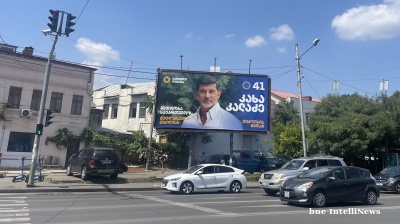Claims that Turkey’s finance minister Mehmet Simsek is on the point of quitting have been denied by the country’s presidency.
Rumours of an impending resignation circulated after on July 25 columnist Nuray Babacan referred in Nefes Gazetesi to speculation that Simsek could leave his post in the autumn, with Vice President Cevdet Yilmaz being considered as a replacement.
Babacan cited sources within the ruling Justice and Development Party (AKP). They claimed ex-Wall Street banker Simsek—previously finance minister from 2009 to 2015 and brought back two years ago to rescue the Turkish economy—had grown increasingly frustrated with internal pressures such as “lobbying for privileged loans and special treatment for pro-government companies”. According to Babacan’s sources, Simsek voiced his concerns directly to President Recep Tayyip Erdogan, reportedly saying: “I can understand criticism from the opposition, but it’s difficult to accept such behaviour from our own ranks during such a critical period [for the economy].”
On July 17, bne IntelliNews noted that “with grumbling evident from lira investors, Bloomberg reported that central bank governor Fatih Karahan told investors during a closed-door meeting in London that deposit choices were being followed. Last weekend, Simsek was in meetings with ruling Justice and Development Party (AKP) officials during a party event. Media reports suggested he was coming under attack. On July 16, the finance ministry said Simsek was not personally expecting a rate cut on July 24 [at the scheduled central bank rates meeting], but was simply discussing market expectations.”
The Erdogan administration’s Directorate for Combatting Disinformation (DMM) firmly denied the claims suggesting Simsek is heading for the exit. It said the rumours were “entirely baseless.”

June 2023: Erdogan (right) congratulates Simsek (left) after announcing him as the new finance minister (Credit: Turkish presidency).
Turkey’s economic roadmap—billed as “orthodox” economics, anchored in the government’s medium-term economic programme and the 12th development plan, following years of far from orthodox “Erdoganomics” that critics say took the economy to the verge of a complete meltdown—is being implemented with full commitment, regime officials say.
The statement from the DMM warned against “manipulative content disguised as insider information”, arguing that such speculation undermines investor confidence and public trust in economic governance.
Yeni Safak, a pro-government newspaper, has repeatedly criticised the central bank’s “high interest rate strategy”.
On the day of the central bank’s latest rates decision, the publication ran a front-page headline declaring: “The nation’s money has been handed to interest profiteers.”
The article accused the central bank of enriching “a small elite at the expense of 85mn citizens”, claiming that over the past two years, Turkish lira (TRY) 1.1 trillion ($27.1bn) in interest payments were made from the state coffers.
In April, Simsek, a former investment banker at Merrill Lynch and former economist at the US embassy in Ankara, was described by Turkey’s main opposition party as the finance arm of the “coupist junta”.
The rates move decided on by the central bank, the CBRT—a cut in the one-week repo rate by 300bp to 43.00%—was termed by Capital Economics “a slight dovish surprise”, though it added that “the accompanying communications remained hawkish and we expect the pace of the easing cycle to slow down from here”.
Timothy Ash, a veteran Turkey analyst and senior EM sovereign strategist at BlueBay Asset Management, said in a note that the CBRT had “fluffed its lines” with its rates move when it had “a chance to get ahead of the curve in terms of anchoring inflation expectations lower”.
He wrote: “I guess part of the problem here is that there has been a lot of communication with the market in recent weeks – the [central bank] governor Fatih Karahan and [deputy governor] Hatice Karahan had met investors in London and Istanbul and the overwhelming feedback was that they both came across hawkish. The market had priced in 350bp in cuts, then after all these meetings expectations dropped to 250bp in cuts, and now they end up disappointing with 300bp in cuts. But if we had not had the prior communication, then delivering 300bp on 350bp in expectations would have been seen as a positive hawkish message.
“Net net – an opportunity has been lost I think, and the CBRT needs to think a bit about its communication with the market.”
Ash concluded: “In the end though, inflation is around 35%, policy rates are now at 43% and with compounding, much higher, so policy is tight. But is it tight enough to get to the CBRT's end year forecast of 28%? Not sure in my mind.
“And all this will just raise questions again about the real independence of the CBRT.”
Capital Economics analyst Nicholas Farr forecast that Turkey’s one-week repo rate will end the year at 37.00%.
The rate move was the first interest rate cut introduced since the Turkish lira (TRY) sell-off in March triggered by the taking into custody of long-ruling Erdogan’s chief political rival, Istanbul mayor Ekrem Imamoglu, which forced the CBRT to reverse its easing cycle.
“Before then, previous interest rate cuts had been in 250bp steps, and most analysts had expected the CBRT to restart the easing cycle at the same pace today,” said Farr.
He added: “It is not entirely clear what drove policymakers to restart the easing cycle at a faster pace. The accompanying statement suggests that the CBRT has become a bit more confident about disinflationary pressures stemming from weakening domestic demand. Policymakers will have also likely been encouraged by reduced pressure on the currency over recent months.
“In any case, the communications still felt hawkish overall, emphasising that a tight monetary stance will be maintained. And the statement noted that ‘the step size will be reviewed prudently on a meeting-by-meeting basis’. We continue to think that interest rate cuts will become smaller over the coming months. We forecast three 200bp cuts over the three remaining meetings this year, taking the policy rate to 37.00%.”
Features

World GDP forecasts raised, but US slowdown anticipated - Fitch
Global growth is now forecast to be 2.4% in 2025, up 0.2pp since June but a sizeable slowdown from 2.9% last year and below trend.

Moldova’s dramatic energy sector transformation
Chisinau ended decades of dependence on Russia in just four years — but will the upcoming general election derail the remaining reforms?

Local elections loom in Georgia
Georgia’s October 4 municipal elections are already mired in controversy amid a partial opposition boycott and mounting state repression, as major international observers refuse to participate.

Iran's nuclear materials 'Under rubble of attacks', Foreign Minister claims
Iran's Araghchi says that the only nuclear site currently accessible is the Russian-controlled Bushehr nuclear power plant in his meeting with the IAEA.




